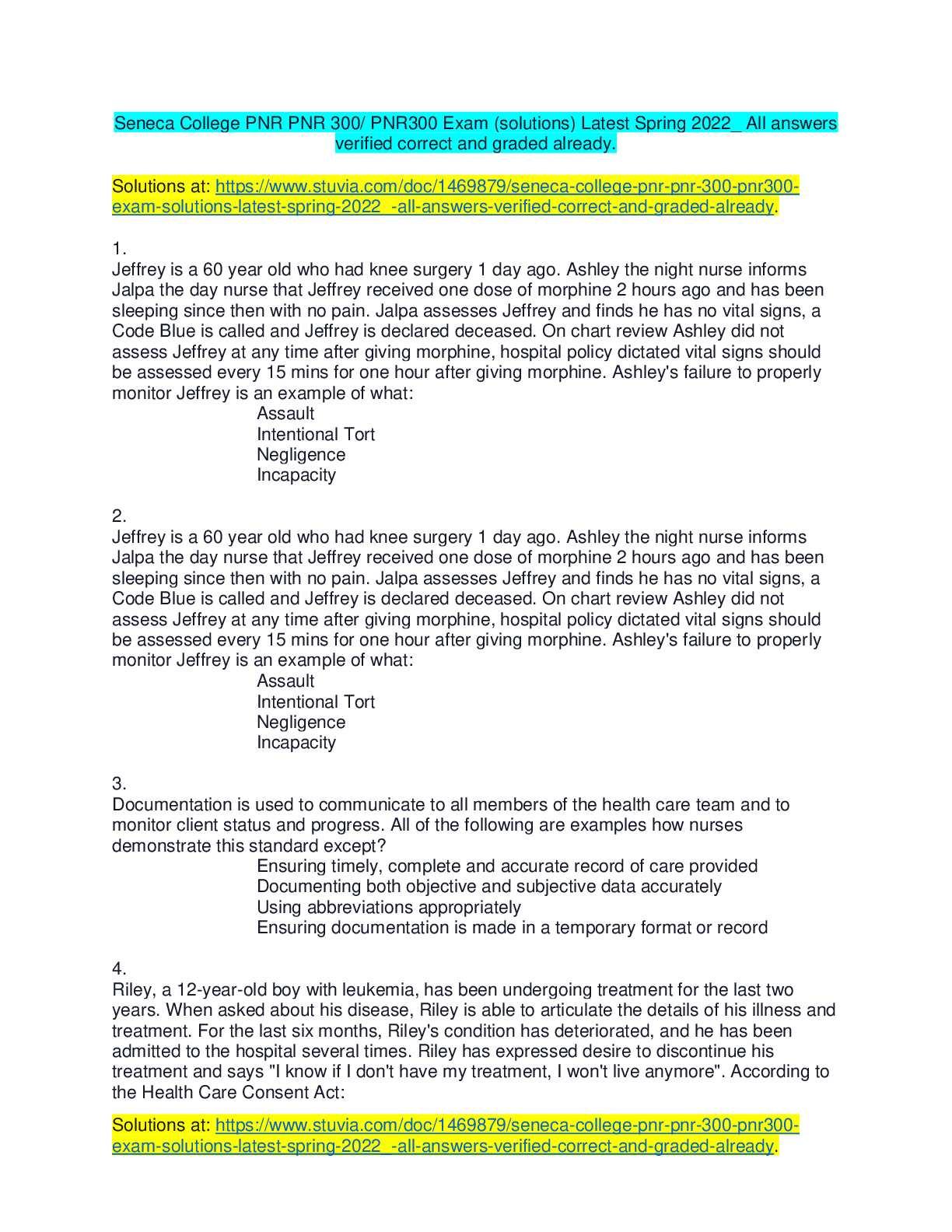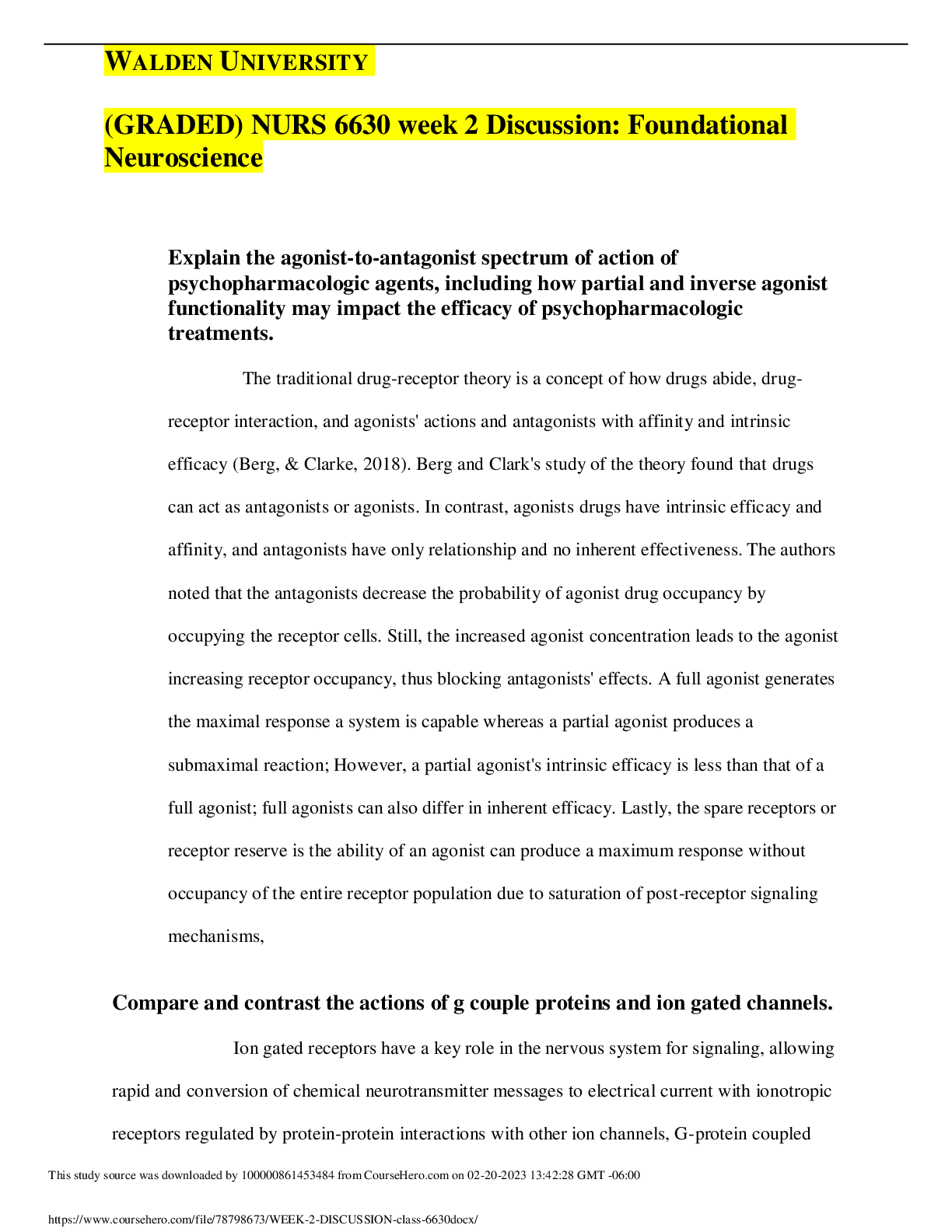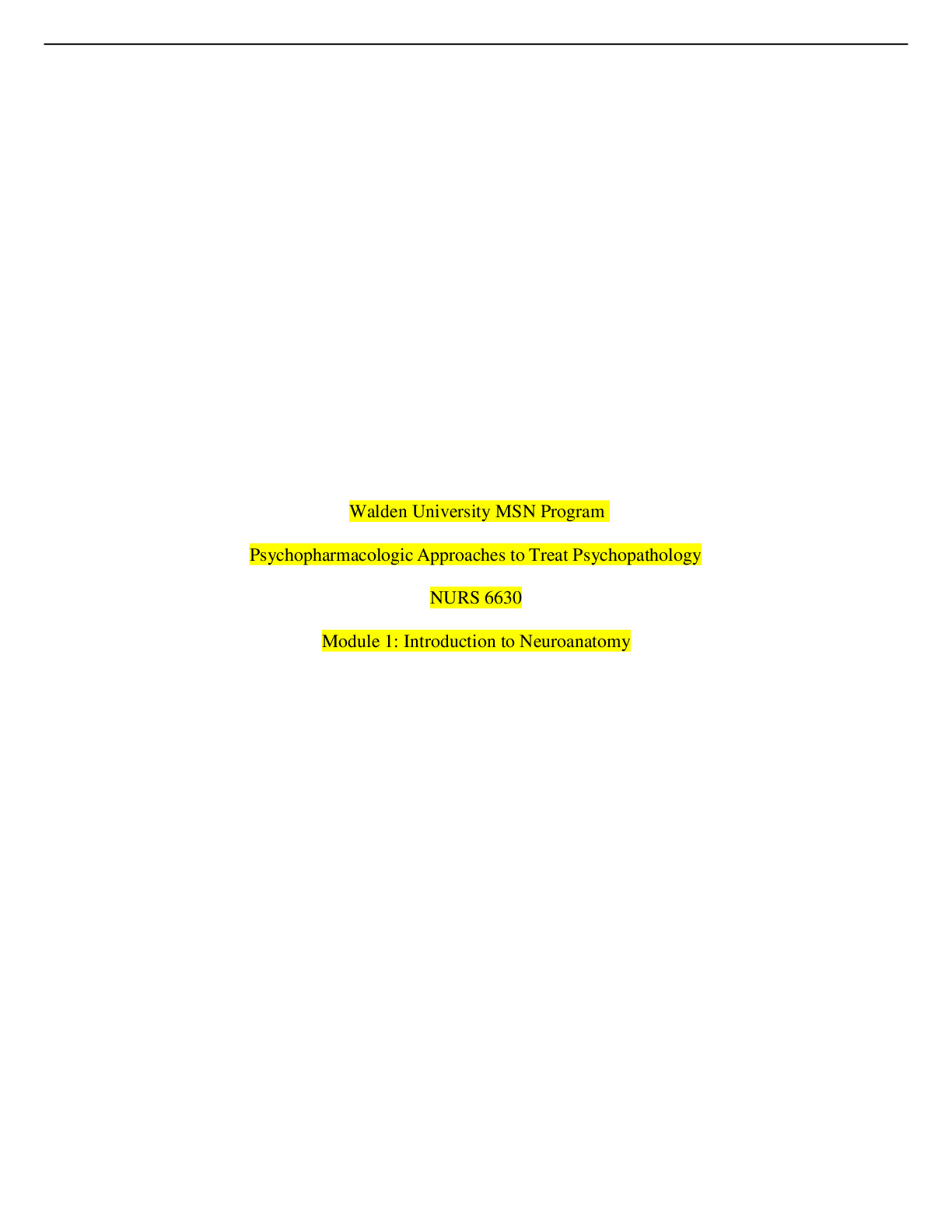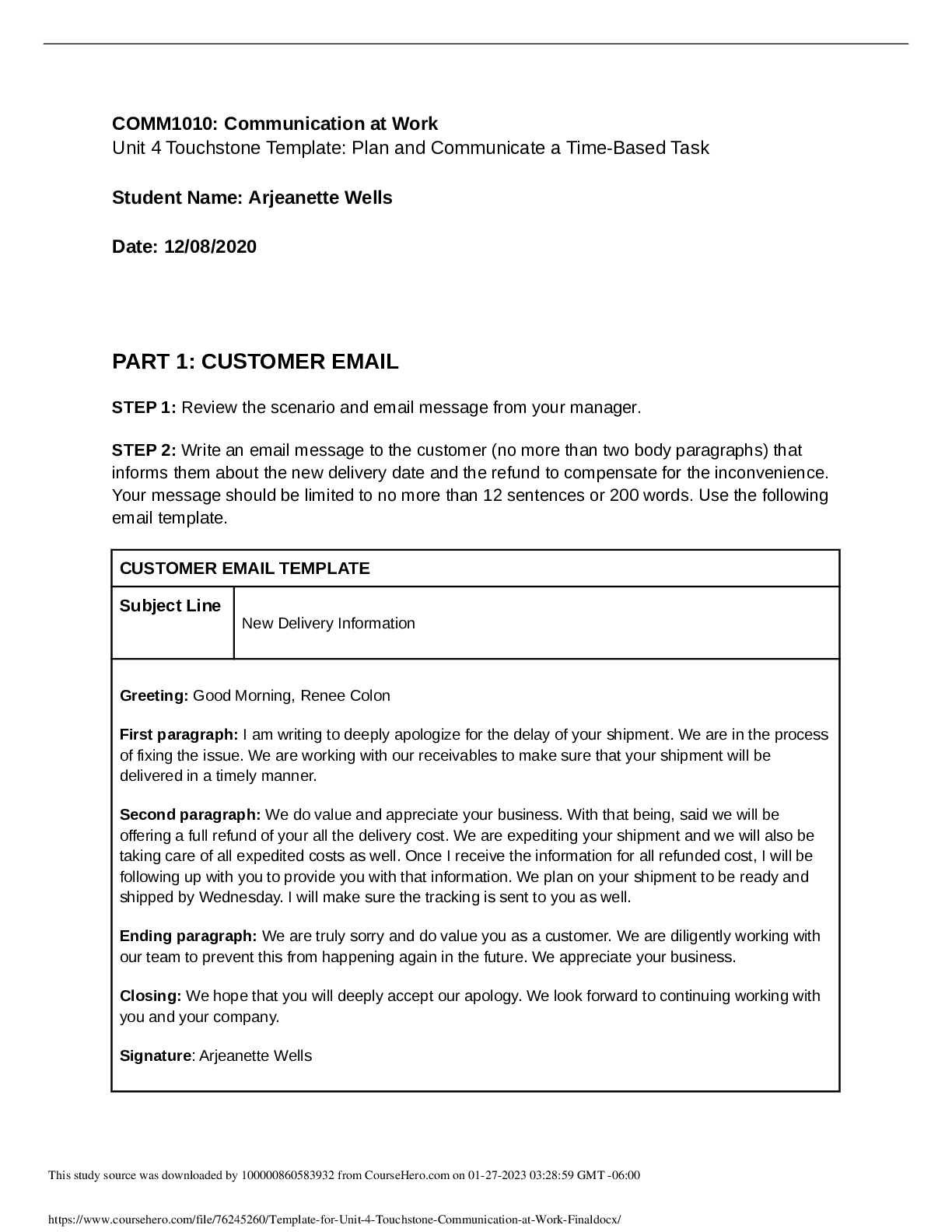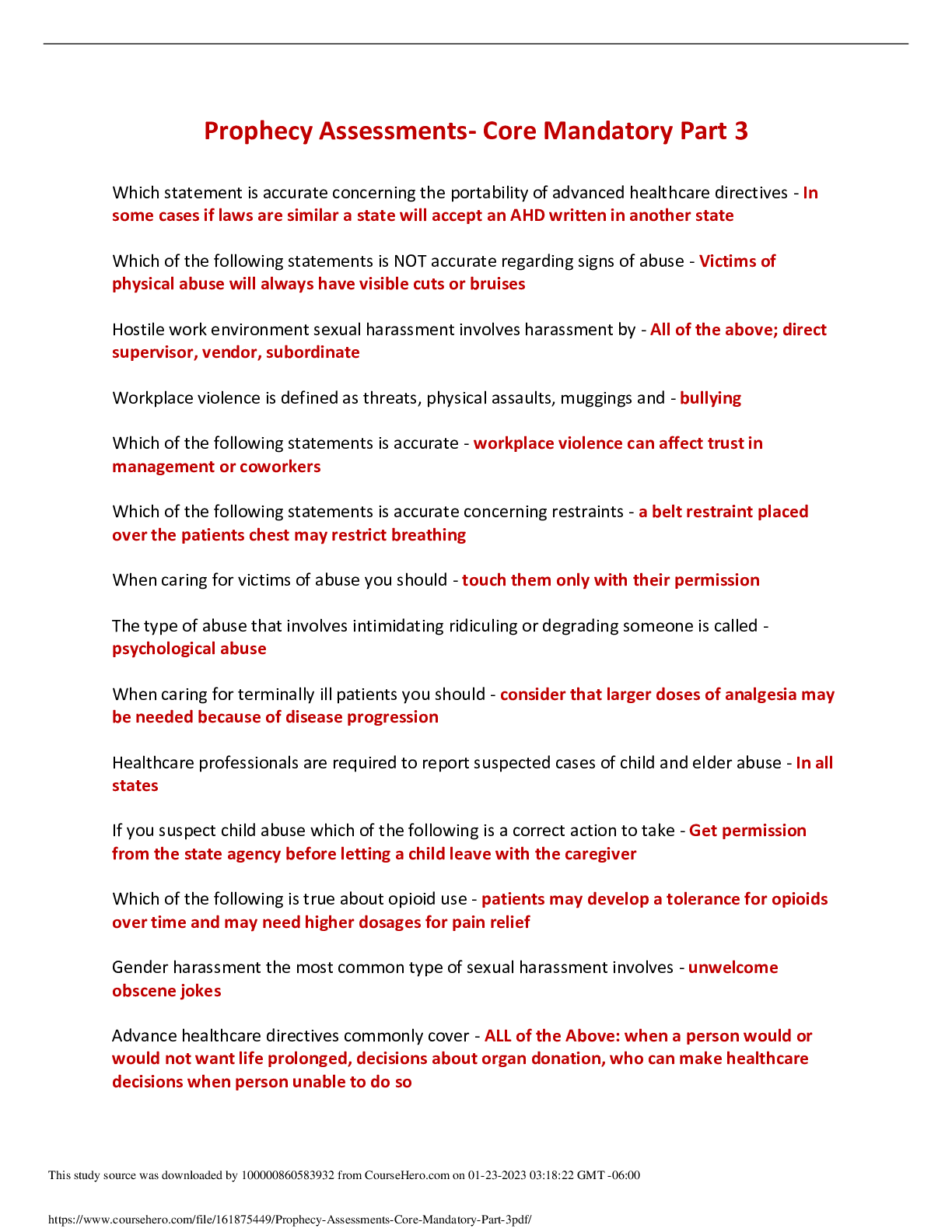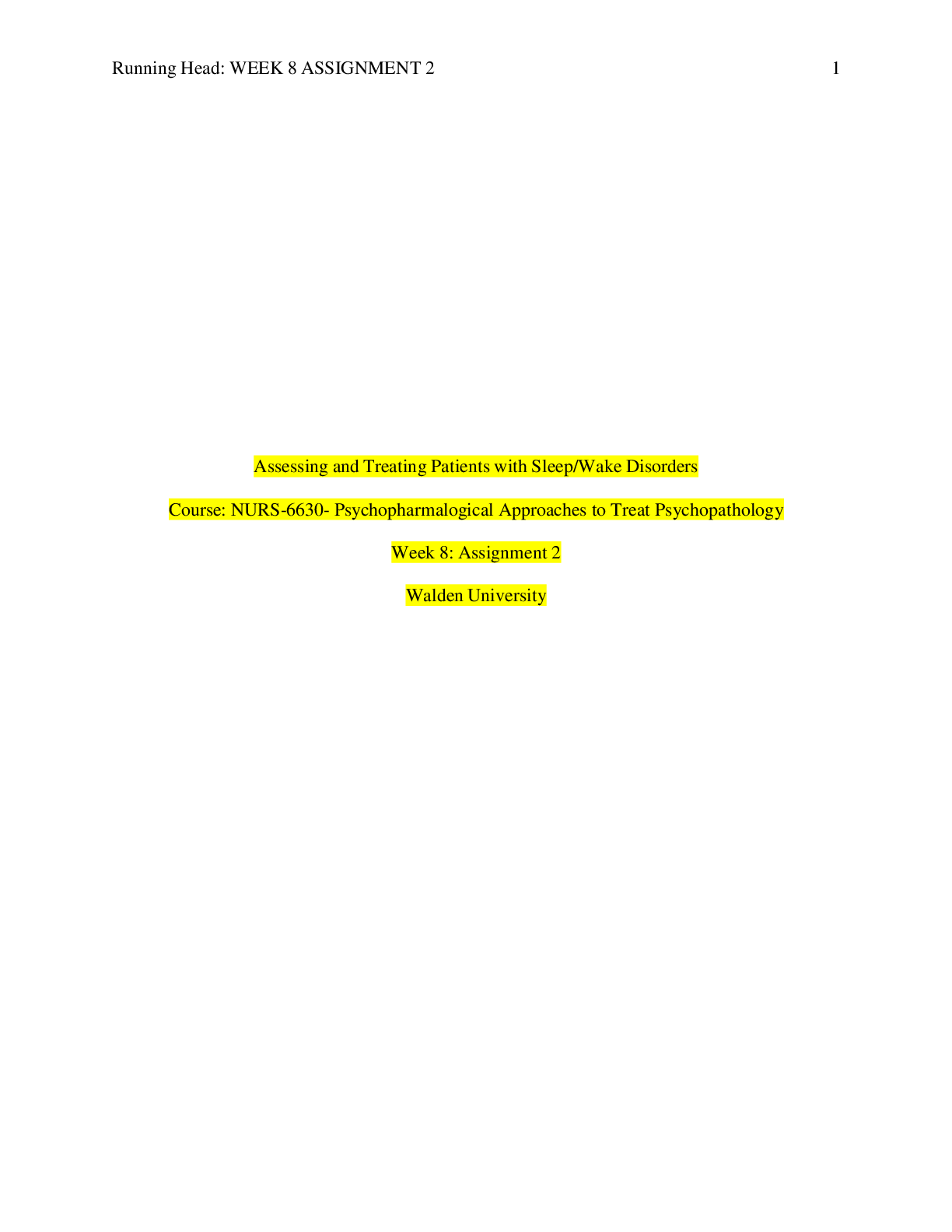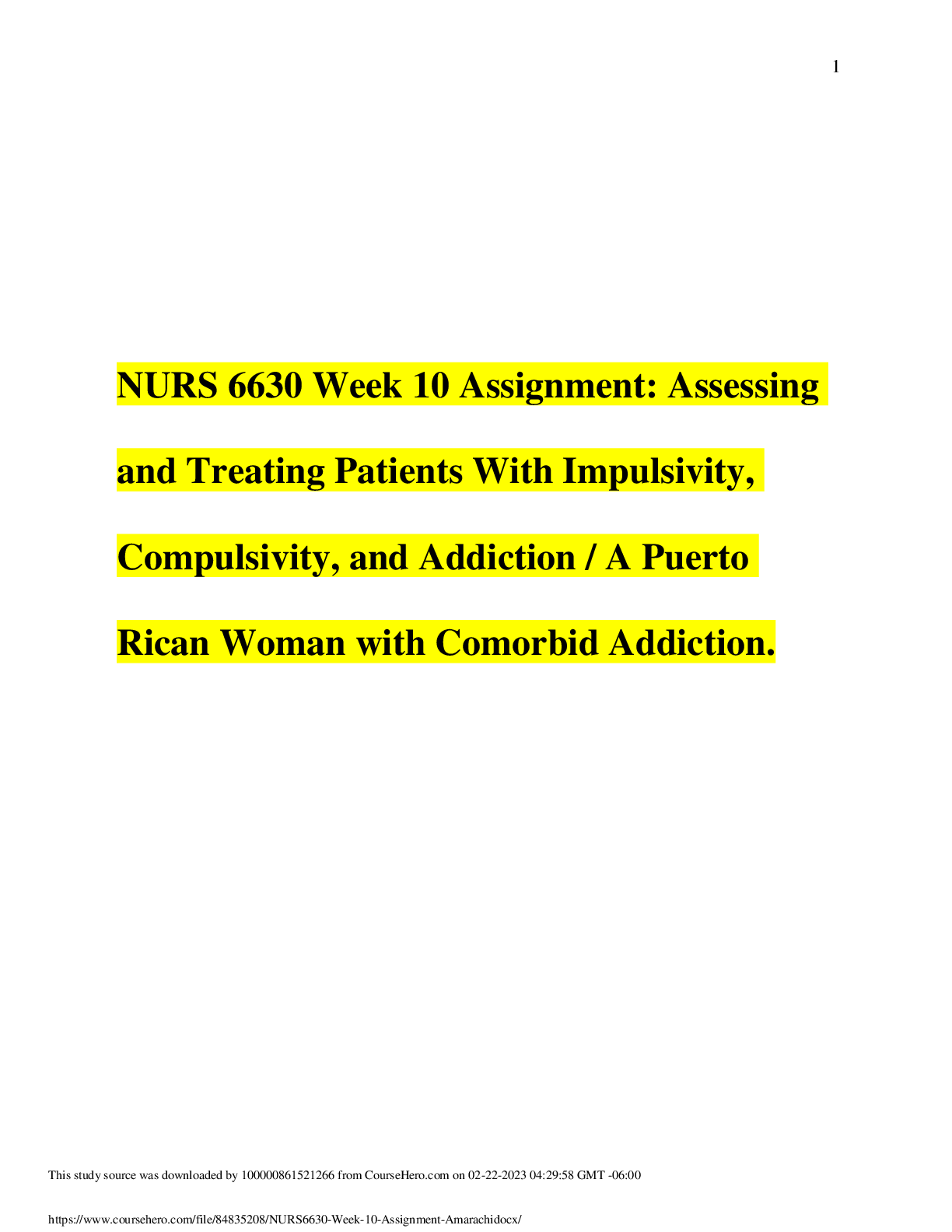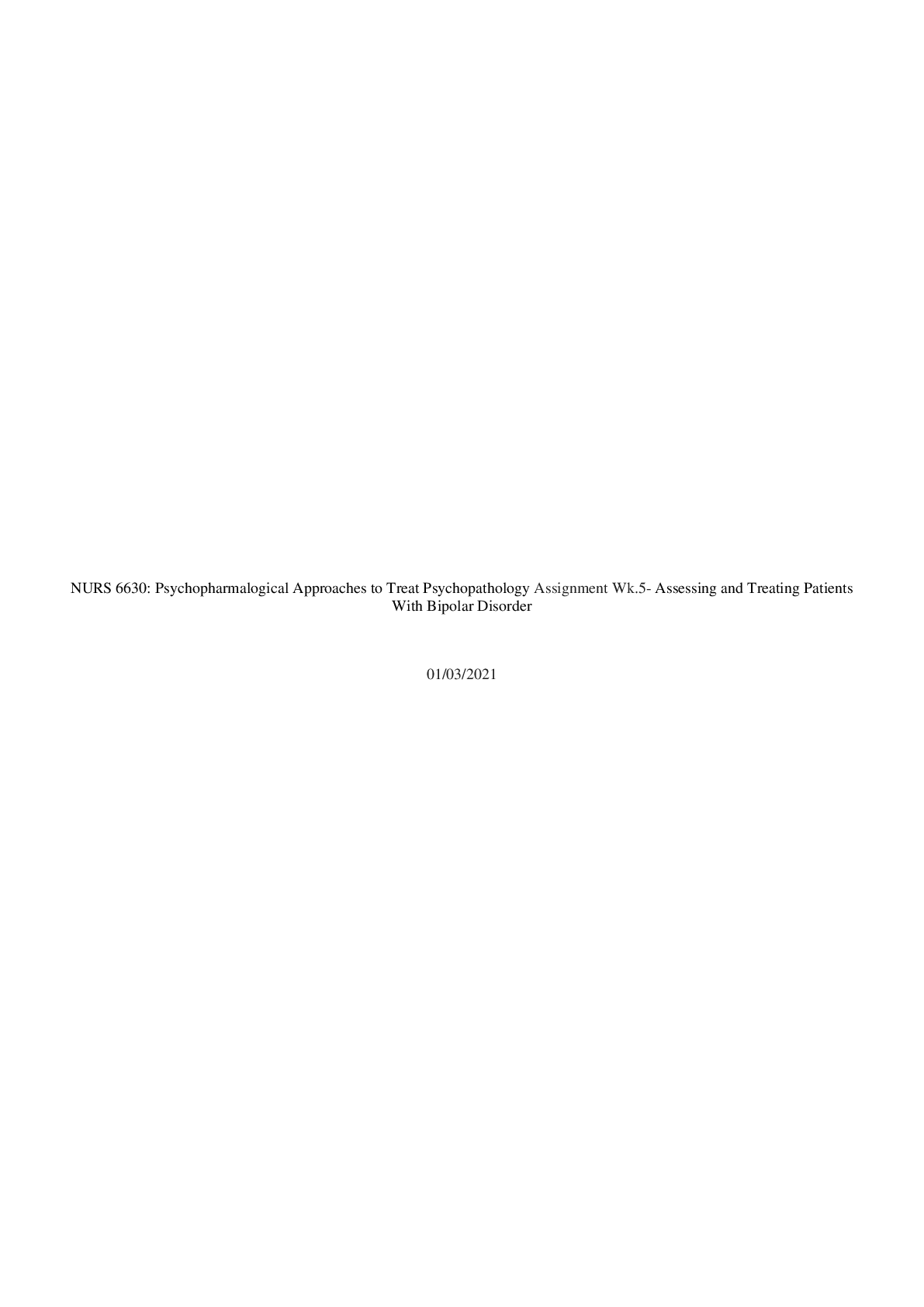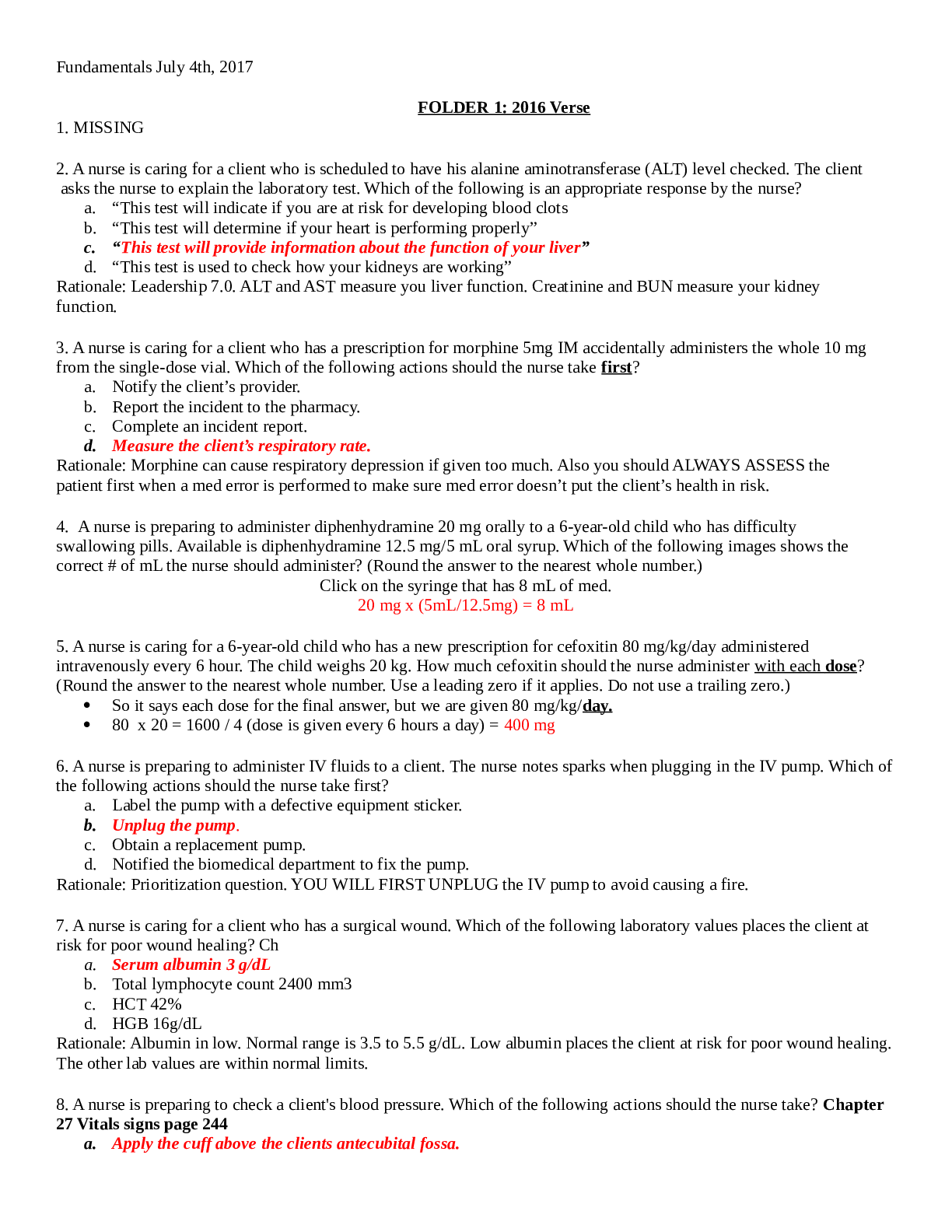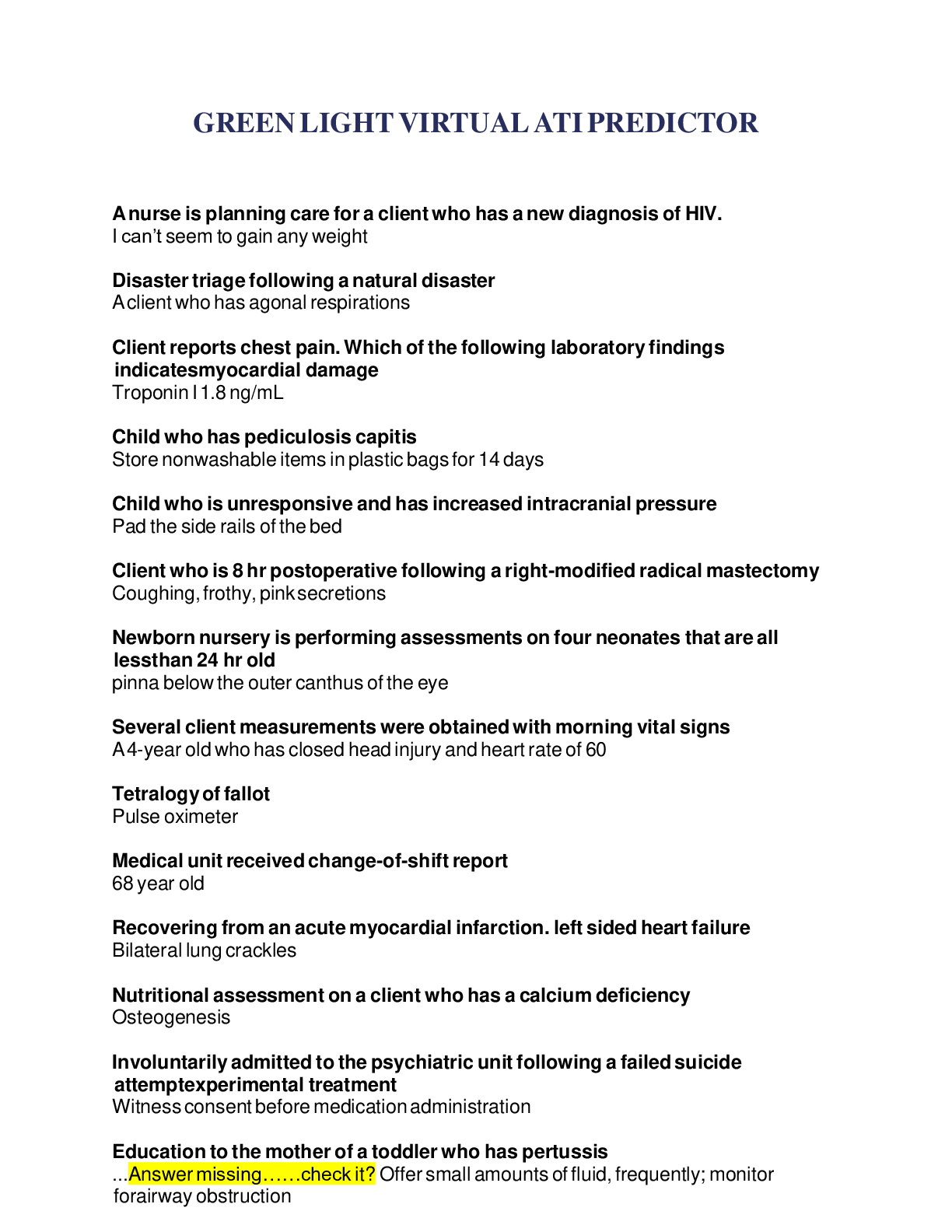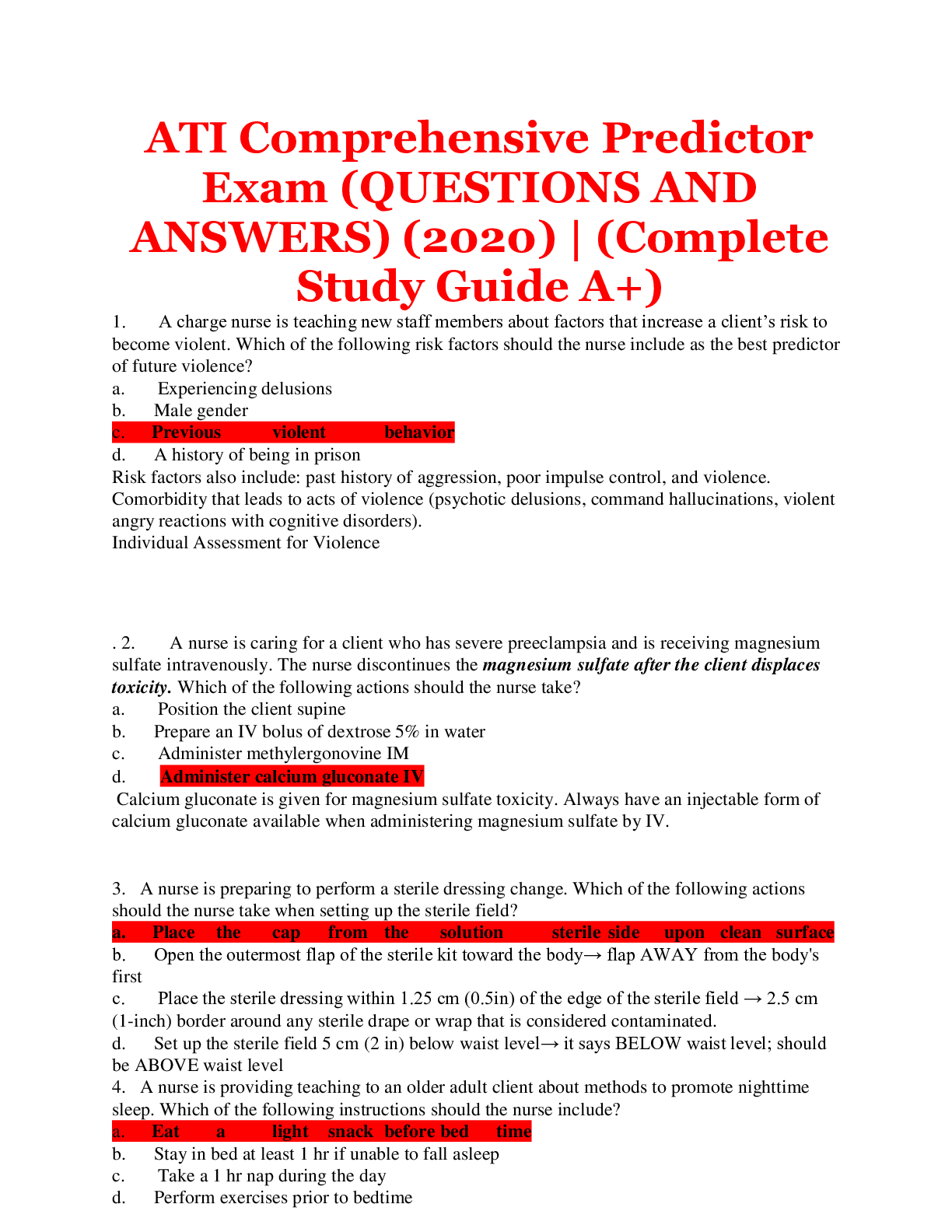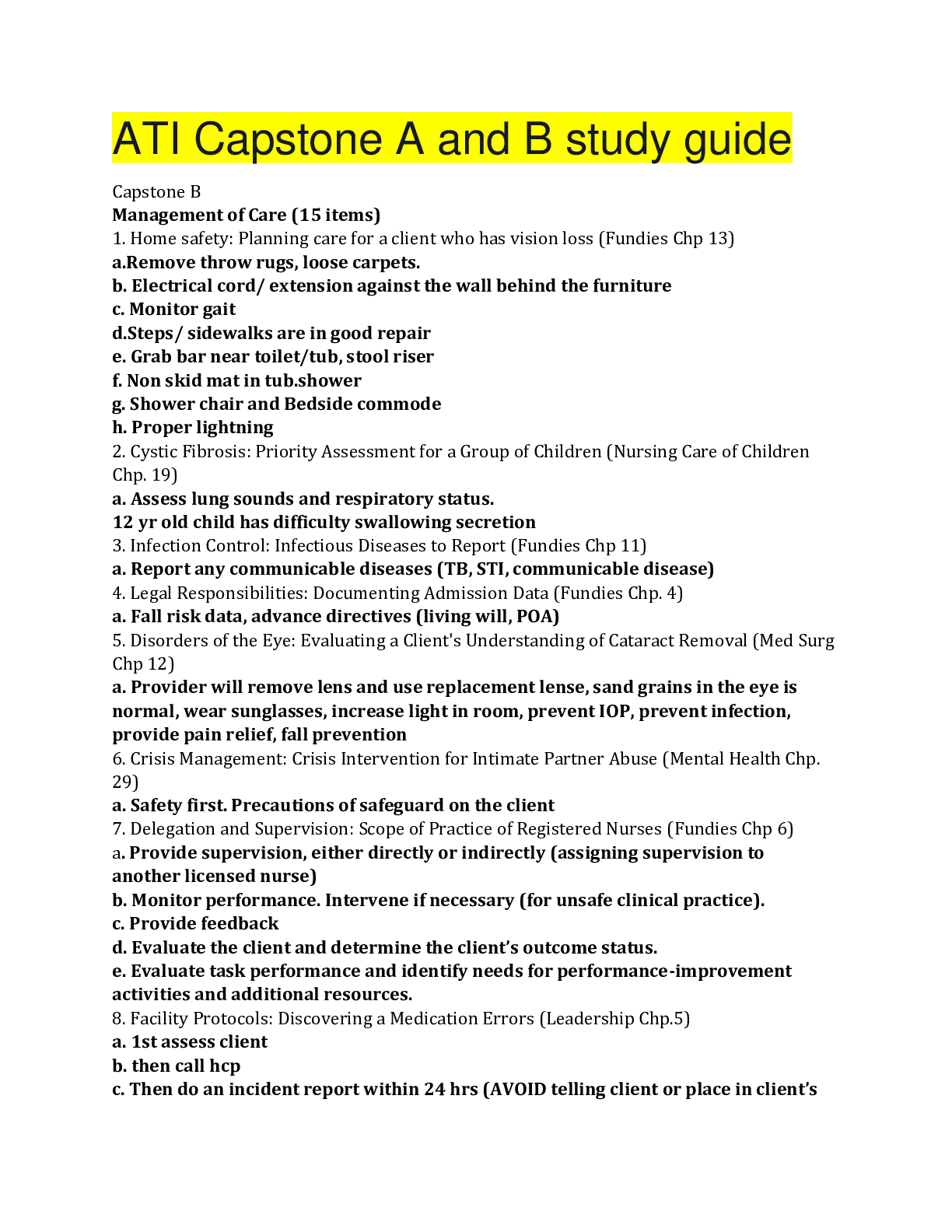*NURSING > QUESTIONS and ANSWERS > (Solution) NURS 6630 Week 10 Assignment: Assessing and Treating Patients With Impulsivity, Compulsiv (All)
(Solution) NURS 6630 Week 10 Assignment: Assessing and Treating Patients With Impulsivity, Compulsivity, and Addiction / A Puerto Rican Woman with Comorbid Addiction.
Document Content and Description Below
Week #10 Assignment: Assessing and Treating Patients with Impulsivity, Compulsivity, and Addiction Name College of Nursing-PMHNP, Walden University NURS 6630: Psychopharmalogical Approaches to Tre... at Psychopathology Professor Due date 2 Assessing and Treating Patients with Impulsivity, Compulsivity, and Addiction Gambling disorder is a psychiatric disorder characterized by recurrent, maladaptive gambling behavior leading to clinically distressing symptoms. In DSM 5, gambling disorder is classified as a substance-related and addictive disorder. The categorization of gambling disorder as a substance-related and addictive disorder was made because of the similarities between it and substance use disorders. Menchon et al., (2018) wrote that numerous studies found that substance use disorders and gambling disorders have analogous characteristics in reference to their diagnostic criteria and symptomology, high comorbidity rates, genetic vulnerabilities, and their relationship with cognitive deficits and biological markers. Martinac et al., (2019) added that up to 73% of gamblers suffer from alcohol addiction and alcoholics are five to six times more predisposed to developing a gambling disorder. Notably, the severity of gambling disorder is directly associated with alcohol consumption levels. Purpose statement The purpose of this paper is to assess and treat Mrs. Maria Perez, a 53-year-old Puerto Rican female who presented to the psychiatric clinic with what she termed as an “embarrassing problem.” The patient admitted that she had alcohol use problems since her late teens when her father died. She also stated that she has been on and off Alcoholics Anonymous for the past 25 years. In the past two years, she experienced difficulties maintaining her sobriety after a casino near her home was opened. Mrs. Perez admitted to drinking alcohol while gambling to keep her calm during high-stakes games, which leads to more reckless gambling and drinking. Although she attempted quitting alcohol, her gambling habits made it difficult to quit. Her cigarette smoking habits also increased. The patient is concerned about her spending habits as she 3 borrowed $50,000 from her retirement account to pay off her gambling debts without her husband’s knowledge. She is also worried about weight gain resulting from excessive alcohol consumption as she has gained about 7lbs. Mental status exam findings show that the patient has challenges with impulse control. The goal for managing Mrs. Perez is to assist her in the gradual reduction of gambling habits and substance abuse disorder. By the end of three months, the PMHNP aims to achieve at least 75% symptom reduction as evidenced by reduced visits to the casino, reduced alcohol consumption and cigarette smoking, and reduced financial expenses linked to gambling. While managing this patient, specific factors should be considered. First, the patient abuses alcohol. She has also gained weight, and she demonstrates impulsivity. Decision #1 The initial decision in managing Mrs. Perez is to prescribe naltrexone 380mg IM on the gluteus region every four weeks. This decision is informed by evidence from several clinical trials confirming its efficacy in alleviating gambling and substance abuse habits. Kim et al., (2001) found that naltrexone 25mg/day reduced gambling symptoms measures considerably. For instance, patient-rated and clinician-rated Clinical Global Impression (CGI) improved by p<.001, Gambling symptom rating scale improved by p<.019. At the end of their study, 75% of naltrexone-treated patients were much or very much improved than 24% of placebo-treated patients. Additionally, Huang et al., (2006) found that naltrexone significantly reduced alcohol craving among people with gambling disorder (p<.001). Grant et al., (2008) found that naltrexone regardless of the dosage reduced gambling urges (p=.0053) and behavior in gambling disorder (p=.0134). Besides, naltrexone-treated patients had greater improvements in gambling 4 severity (p=.0080) than placebo-treated patients. Morley et al., (2006) also conducted a randomized control trial to compare the efficacy of naltrexone and acamprosate and found that naltrexone resulted in a significant reduction in alcohol dependence than acamprosate (p<0.05). Maisel et al., (2013) found that naltrexone is efficacious in reducing heavy drinking and craving while acamprosate resulted in statistically significant results in maintaining abstinence (p<.005). The PMHNP did not prescribe disulfiram 250mg because the patient is currently taking alcohol. Patkar et al., (2013) cite that disulfiram interferes with alcohol metabolism, thus, leading to acetaldehyde accumulation which results in side effects such as tachycardia, flushing, and sweating that may result in non-adherence. Besides, Grant et al., (2017) found that disulfiram did not result in a beneficial response in reducing problem-gambling features while naltrexone did. The PMHNP did not also select acamprosate because it is efficacious in abstinence instead of reducing gambling urges, which the patient is suffering from. The aim of prescribing naltrexone IM is to reduce the number of visits by the patient to the casino, alcohol abuse, and cigarette smoking by 35% by the end of four weeks. According to Kovanen et al., (2016), naltrexone-treated participants demonstrated a 38% reduction in gambling urges in a month. Some of the ethical issues impacting Mrs. Perez’s treatment plan and communication include seeking informed consent by educating the patient about her condition and available treatment options. The PMHNP should also educate the patient on concerns while using naltrexone. For example, concomitant use of opioids such as morphine and codeine may not be effective while using naltrexone (Toneatto et al., 2009). This allows the patient to make informed choices. The PMHNP also upheld beneficence by choosing an evidence-based option whose 5 safety and efficacy is confirmed by clinical trials. Communication with the patient should uphold patient confidentiality. Decision #2 The next decision in managing Mrs. Perez was informed by outcomes after administering naltrexone 380mg IM. The patient reported that she did not drink any alcohol in the past four weeks. She also reported a reduced frequency of visiting the casino but considerable spending, anxiety, and continued cigarette smoking. Therefore, the next decision was to continue naltrexone administration and refer the patient to a counselor for psychotherapy. According to Choi et al., (2017), there is no FDA-approved medication for gambling disorder. Psychotherapy for gambling disorder utilizes similar principles as those used in addiction because they have shared themes, including loss of control, continued gambling despite knowledge of its deleterious effects, and preoccupation. Psychotherapeutic approaches commonly employed for gambling disorder include cognitive-behavioral therapy and motivational interviewing that change the patient’s cognitions about gambling and allow them to adopt adaptive behaviors and promote motivation for change (Choi et al., 2017). The PMHNP did not add diazepam to manage Mrs. Perez’s anxiety because it is a benzodiazepine. Benzodiazepines are contraindicated among patients with alcohol use disorders because of the risk of dependence, overdose, and death. Schimtz (2016) also wrote that alcohol enhances the sedative effects of benzodiazepines, and their combination is linked to fatal consequences such as coma and death induced by respiratory depression. Diazepam in this case is suggested as an option to alleviate the patient’s anxiety, which is a side effect of naltrexone. Stahl (2013) asserts that medications should not be added to a patient’s regimen to manage 6 another medication’s side effects. The PMHNP did not also add Chantix despite its known efficacy in smoke cessation. The standard starting dose of Chantix is 0.5mg rather than 1mg. However, it can be titrated gradually to 2mg/day (Hajek et al., 2015). By prescribing 1mg/day of Chantix, the PMHNP predisposes the patient to unwanted side effects such as nightmares, severe nausea and vomiting, and agitation. The aim of referring Mrs. Perez to a counselor for psychotherapy is to reduce gambling by 75% based on baseline behaviors and maintain alcohol cessation. Besides, the PMHNP aims at reducing the patient’s cigarette smoking habits by at least 25%. Since psychotherapy teaches patients about how to identify maladaptive thoughts and behaviors and motivates them to change, the PMHNP aims to improve all behaviors linked to lack of impulse control. In this phase, some of the ethical considerations impacting the patient’s treatment plan and communication are issues of consent, maintaining patient confidentiality, and veracity. The PMHNP should seek Mrs. Perez’s consent to refer her to a counselor and demonstrate truthfulness when communicating with the patient by informing her that the mainstay of management for gambling disorder is psychotherapy. The PMHNP should also seek the patient’s consent to share her information with the counselor. Decision #3 Four weeks later, the patient returned stating that her anxiety had gone and she did not like her counselor. She also began attending a local meeting of Gamblers Anonymous and that she felt supported in the group. The next decision is to explore the issue Mrs. Perez is having with her counselor and encourage her to continue attending the Gamblers Anonymous meetings. Exploring issues in the therapeutic relationship between Mrs. Perez and her counselor is crucial 7 to promoting the attainment of patient goals. A therapeutic relationship is the quality of the bond between a therapist and a client and the overall approach to therapy. The therapeutic relationship is a reliable and substantial contributor to client goal attainment (Stargell, 2017). A break in the therapeutic alliance is attributed to the discontinuation of th [Show More]
Last updated: 1 year ago
Preview 1 out of 11 pages

Reviews( 0 )
Document information
Connected school, study & course
About the document
Uploaded On
Jan 26, 2023
Number of pages
11
Written in
Additional information
This document has been written for:
Uploaded
Jan 26, 2023
Downloads
0
Views
75



